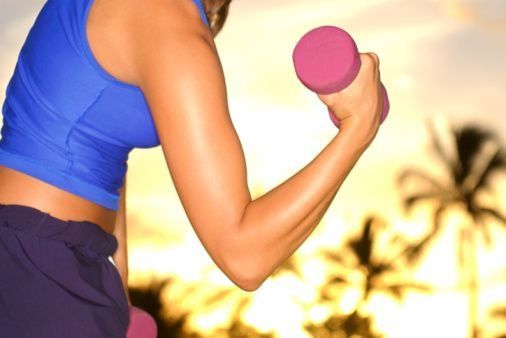After women reach their 40s, muscle mass in the arms may begin to decrease. Whether you loathe wobbly arms or don't mind a little extra flab, you should know that toning the arms isn't just a vanity issue, because strength is associated with healthy aging and body weight.
Arm-strengthening exercises have the added benefit of working the muscles in your lower back and shoulders, which may lead to better posture. Also, strength-training exercises are known to help prevent osteoporosis and bone fractures.
It may be a good idea to invest in two sets of dumbbells, depending on your current strength. Sets of three- to five-pound weights are ideal for beginners, and you should move up to eight- to 10-pound dumbbells when you feel comfortable. A lightweight alternative that's also good for travel is a resistance band, a rubber device that can be stretched and pulled to tone muscles.
Plan on doing arm exercises two or three times per week on nonconsecutive days for optimal results. Aim to do two sets of 10 to 12 repetitions, taking short breaks in between.
If you're using dumbbells or hand weights, you can simultaneously strengthen your abs and arms with the sit-up pullover. For this exercise, begin by lying on your back with knees bent and arms extended overhead, holding the weights. Engage your abs and slowly curl up, bringing your arms over your head to your knees. Hold this pose for a second or two, then reverse the movement.
The overhead triceps extension may help firm up the underarm, a common problem area. Begin standing with feet hip-width apart and a weight in one hand, arm extended overhead. You can stabilize the weight-bearing arm by holding the elbow with your opposite hand. Slowly bend your extended arm downward, then bring it back up. Do this for both arms.
It's easy to do a biceps curl using a resistance band. Just secure the band under your feet while standing with feet hip-width apart, and hold the ends of the band in each hand. You can increase or decrease resistance by wrapping excess material around the hands. Keep your elbows in and slowly curl the arms up, engaging the biceps. It's important to keep your shoulders stabilized while doing this exercise—only the elbows should move.
HealthyWomen content is for informational purposes only. Please consult your healthcare provider for medical advice, diagnosis or treatment.


Why Are More Non-Smokers Getting Lung Cancer?
Smoking is the biggest risk factor for lung cancer, but environmental pollutants could be driving a rise in younger non-smokers
iStock.com/eternal creative
Your Guide to Colon Cancer Screening Tests
Knowing your colon cancer test options may help you decide which one is right for you
iStock.com/jaruno11
¿Por qué personas que no fuman están desarrollando cáncer pulmonar?
Fumar es el factor de riesgo más importante de cáncer pulmonar, pero contaminantes medioambientales podrían estar impulsando un incremento de esta enfermedad en personas más jóvenes que no fuman
iStock.com/eternal creative
Why Are Women of Color More at Risk for Lupus?
Women make up 9 out of 10 lupus cases, but women of color — especially Black women — are more likely to suffer from this autoimmune disease
Happy Hour Is on the Rocks: Alcohol and Breast Cancer Advisory
The U.S. surgeon general has issued a strong warning about the link between alcohol and breast cancer and six other cancers
iStock/MTStock Studio
